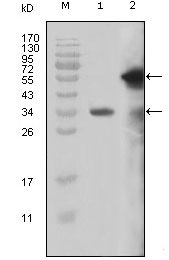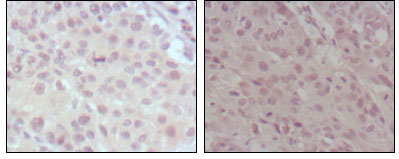MLL Antibody
Purified Mouse Monoclonal Antibody
- SPECIFICATION
- CITATIONS
- PROTOCOLS
- BACKGROUND

Application
| WB, IHC, E |
|---|---|
| Primary Accession | Q03164 |
| Reactivity | Human |
| Host | Mouse |
| Clonality | Monoclonal |
| Clone Names | 10F8D7 |
| Isotype | IgG1 |
| Calculated MW | 431764 Da |
| Description | Myeloid/lymphoid or mixed-lineage leukemia (trithorax homolog, Drosophila). Eukaryotic RNA polymerase II mediates the synthesis of mature and functional messenger RNA. This is a multistep process, called the transcription cycle,that includes five stages: preinitiation, promoter, clearance, elongation and termination. Elongation is thought to be a critical stage for the regulation of gene expression. ELL (11-19 lysine-rich leukemia protein, also designated MEN)functions as an RNA polymerase II elongation factor that increases the rateof transcription by suppressing transient pausing by RNA polymerase II. Also, ELL is thought to regulate cellular proliferation. ELL is abundantly expressed in peripheral blood leukocytes, skeletal muscle, placenta and testis, and has lower expression in spleen, thymus, heart, brain, lung, kidney, liver and ovary.The gene encoding human ELL, which maps to chromosome 19p13.1, is one of several genes which undergo translocation with the MLL gene on chromo-some 11q23 in acute myeloid leukemia. MLL (myeloid/lymphoid leukemia,also designated ALL-1 and HRX) is a 430 kDa protein that regulates embryonal and hematopoietic development. |
| Immunogen | Purified recombinant fragment of MLL (aa3751-3968) expressed in E. Coli. |
| Formulation | Ascitic fluid containing 0.03% sodium azide. |
| Gene ID | 4297 |
|---|---|
| Other Names | Histone-lysine N-methyltransferase 2A, Lysine N-methyltransferase 2A, 2.1.1.43, ALL-1, CXXC-type zinc finger protein 7, Myeloid/lymphoid or mixed-lineage leukemia, Myeloid/lymphoid or mixed-lineage leukemia protein 1, Trithorax-like protein, Zinc finger protein HRX, MLL cleavage product N320, N-terminal cleavage product of 320 kDa, p320, MLL cleavage product C180, C-terminal cleavage product of 180 kDa, p180, KMT2A, ALL1, CXXC7, HRX, HTRX, MLL, MLL1, TRX1 |
| Dilution | WB~~1/500 - 1/2000 IHC~~1/200 - 1/1000 |
| Storage | Maintain refrigerated at 2-8°C for up to 6 months. For long term storage store at -20°C in small aliquots to prevent freeze-thaw cycles. |
| Precautions | MLL Antibody is for research use only and not for use in diagnostic or therapeutic procedures. |
| Name | KMT2A |
|---|---|
| Synonyms | ALL1, CXXC7, HRX, HTRX, MLL, MLL1, TRX1 |
| Function | Histone methyltransferase that plays an essential role in early development and hematopoiesis (PubMed:15960975, PubMed:12453419, PubMed:15960975, PubMed:19556245, PubMed:19187761, PubMed:20677832, PubMed:21220120, PubMed:26886794). Catalytic subunit of the MLL1/MLL complex, a multiprotein complex that mediates both methylation of 'Lys- 4' of histone H3 (H3K4me) complex and acetylation of 'Lys-16' of histone H4 (H4K16ac) (PubMed:15960975, PubMed:12453419, PubMed:15960975, PubMed:19556245, PubMed:24235145, PubMed:19187761, PubMed:20677832, PubMed:21220120, PubMed:26886794). Catalyzes methyl group transfer from S-adenosyl-L-methionine to the epsilon-amino group of 'Lys-4' of histone H3 (H3K4) via a non-processive mechanism. Part of chromatin remodeling machinery predominantly forms H3K4me1 and H3K4me2 methylation marks at active chromatin sites where transcription and DNA repair take place (PubMed:25561738, PubMed:15960975, PubMed:12453419, PubMed:15960975, PubMed:19556245, PubMed:19187761, PubMed:20677832, PubMed:21220120, PubMed:26886794). Has weak methyltransferase activity by itself, and requires other component of the MLL1/MLL complex to obtain full methyltransferase activity (PubMed:19187761, PubMed:26886794). Has no activity toward histone H3 phosphorylated on 'Thr-3', less activity toward H3 dimethylated on 'Arg-8' or 'Lys-9', while it has higher activity toward H3 acetylated on 'Lys-9' (PubMed:19187761). Binds to unmethylated CpG elements in the promoter of target genes and helps maintain them in the nonmethylated state (PubMed:20010842). Required for transcriptional activation of HOXA9 (PubMed:12453419, PubMed:20677832, PubMed:20010842). Promotes PPP1R15A- induced apoptosis (PubMed:10490642). Plays a critical role in the control of circadian gene expression and is essential for the transcriptional activation mediated by the CLOCK-BMAL1 heterodimer (By similarity). Establishes a permissive chromatin state for circadian transcription by mediating a rhythmic methylation of 'Lys-4' of histone H3 (H3K4me) and this histone modification directs the circadian acetylation at H3K9 and H3K14 allowing the recruitment of CLOCK-BMAL1 to chromatin (By similarity). Also has auto-methylation activity on Cys-3882 in absence of histone H3 substrate (PubMed:24235145). |
| Cellular Location | Nucleus [MLL cleavage product C180]: Nucleus. Note=Localizes to a diffuse nuclear pattern when not associated with MLL cleavage product N320 |
| Tissue Location | Heart, lung, brain and T- and B-lymphocytes. |

Thousands of laboratories across the world have published research that depended on the performance of antibodies from Abcepta to advance their research. Check out links to articles that cite our products in major peer-reviewed journals, organized by research category.
info@abcepta.com, and receive a free "I Love Antibodies" mug.
Provided below are standard protocols that you may find useful for product applications.
References
1. Genet Couns. 2006;17(2):155-9. 2. Cancer Genet Cytogenet. 2006 Jul 15;168(2):162-7 3. Leukemia. 2007 Feb;21(2):360-2. Epub 2007 Jan 4.
If you have used an Abcepta product and would like to share how it has performed, please click on the "Submit Review" button and provide the requested information. Our staff will examine and post your review and contact you if needed.
If you have any additional inquiries please email technical services at tech@abcepta.com.













 Foundational characteristics of cancer include proliferation, angiogenesis, migration, evasion of apoptosis, and cellular immortality. Find key markers for these cellular processes and antibodies to detect them.
Foundational characteristics of cancer include proliferation, angiogenesis, migration, evasion of apoptosis, and cellular immortality. Find key markers for these cellular processes and antibodies to detect them. The SUMOplot™ Analysis Program predicts and scores sumoylation sites in your protein. SUMOylation is a post-translational modification involved in various cellular processes, such as nuclear-cytosolic transport, transcriptional regulation, apoptosis, protein stability, response to stress, and progression through the cell cycle.
The SUMOplot™ Analysis Program predicts and scores sumoylation sites in your protein. SUMOylation is a post-translational modification involved in various cellular processes, such as nuclear-cytosolic transport, transcriptional regulation, apoptosis, protein stability, response to stress, and progression through the cell cycle. The Autophagy Receptor Motif Plotter predicts and scores autophagy receptor binding sites in your protein. Identifying proteins connected to this pathway is critical to understanding the role of autophagy in physiological as well as pathological processes such as development, differentiation, neurodegenerative diseases, stress, infection, and cancer.
The Autophagy Receptor Motif Plotter predicts and scores autophagy receptor binding sites in your protein. Identifying proteins connected to this pathway is critical to understanding the role of autophagy in physiological as well as pathological processes such as development, differentiation, neurodegenerative diseases, stress, infection, and cancer.



